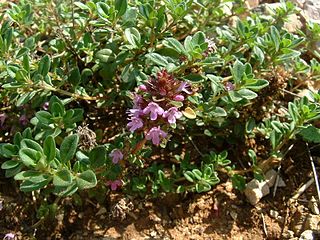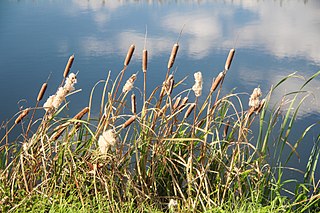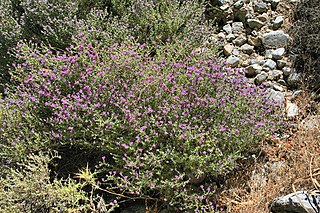
Thyme is the herb of some members of the genus Thymus of aromatic perennial evergreen herbs in the mint family Lamiaceae. Thymes are relatives of the oregano genus Origanum, with both plants being mostly indigenous to the Mediterranean region. Thymes have culinary, medicinal, and ornamental uses, and the species most commonly cultivated and used for culinary purposes is Thymus vulgaris.

Thymol, C10H14O, is a natural monoterpenoid phenol derivative of p-Cymene, isomeric with carvacrol, found in oil of thyme, and extracted from Thymus vulgaris, ajwain, and various other plants as a white crystalline substance of a pleasant aromatic odor and strong antiseptic properties. Thymol also provides the distinctive, strong flavor of the culinary herb thyme, also produced from T. vulgaris. Thymol is only slightly soluble in water at neutral pH, but it is extremely soluble in alcohols and other organic solvents. It is also soluble in strongly alkaline aqueous solutions due to deprotonation of the phenol. Its dissociation constant (pKa) is 10.59±0.10. Thymol absorbs maximum UV radiation at 274 nm.

The genus Thymus contains about 350 species of aromatic perennial herbaceous plants and subshrubs to 40 cm tall in the family Lamiaceae, native to temperate regions in Europe, North Africa and Asia.

Pandanus is a genus of monocots with some 578 accepted species. They are palm-like, dioecious trees and shrubs native to the Old World tropics and subtropics. The greatest number of species are found in Madagascar and Malaysia. Common names include pandan, screw palm and screw pine. They are classified in the order Pandanales, family Pandanaceae.

Thymus serpyllum, known by the common names of Breckland thyme, Breckland wild thyme, wild thyme, creeping thyme, or elfin thyme, is a species of flowering plant in the mint family Lamiaceae, native to most of Europe and North Africa. It is a low, usually prostrate subshrub growing to 2 cm (1 in) tall with creeping stems up to 10 cm (4 in) long. The oval evergreen leaves are 3–8 mm long. The strongly scented flowers are either lilac, pink-purple, magenta, or a rare white, all 4–6 mm long and produced in clusters. The hardy plant tolerates some pedestrian traffic and produces odors ranging from heavily herbal to lightly lemon, depending on the variety.

Typha latifolia, better known as broadleaf cattail, is a perennial herbaceous plant in the genus Typha. It is found as a native plant species in North and South America, Eurasia, and Africa. The T. latifolia genome was published in 2022.

Thymus vulgaris is a species of flowering plant in the mint family Lamiaceae, native to southern Europe from the western Mediterranean to southern Italy. Growing to 15–30 cm (6–12 in) tall by 40 cm (16 in) wide, it is a bushy, woody-based evergreen subshrub with small, highly aromatic, grey-green leaves and clusters of purple or pink flowers in early summer.

Fraxinus angustifolia, the narrow-leaved ash, is a species of Fraxinus native to Central Europe and Southern Europe, Northwest Africa, and Southwest Asia.

Pinhook Bog is a unique bog in Indiana that has been designated a National Natural Landmark. It is part of Indiana Dunes National Park, an area that many citizens, scientists, and politicians fought hard to preserve. Its sister bog, Volo Bog, is located nearby. The bog contains a large variety of plants, including insect eating plants, tamarack trees, stands of blueberry bushes, and floating mats of sphagnum moss. Pinhook Bog is about 580 acres (2.3 km2), a quarter of which is a floating mat of sphagnum peat moss. A "moat" separates the bog from the uplands.

Thymus citriodorus, the lemon thyme or citrus thyme, is a lemon-scented evergreen mat-forming perennial plant in the family Lamiaceae. There has been a great amount of confusion over the plant's correct name and origin. Recent DNA analysis suggests that it is not a hybrid or cross, but a distinct species as it was first described in 1811., yet an analysis in a different study clustered Thymus citriodorus together with Thymus vulgaris, which is considered as one of its parent species.

Turritis glabra, commonly known as tower rockcress or tower mustard, is a tall, slim, grey-green plant with small creamy flowers at the top of the stem. It usually grows on poor chalky or sandy soils, in open situations. It is native to Europe, Asia, and North Africa, and it is widespread in North America where it is also probably native. It can be found in many other parts of the world as an introduced species.

Thymus pseudolanuginosus - commonly called woolly thyme - is now also classified as Thymus praecox subsp. britannicus. It was also formerly known as Thymus lanuginosus.
Trifurcula thymi is a moth of the family Nepticulidae. It is found from Germany and Poland to the Alps and Hungary, as well as in France and the Iberian Peninsula.

Thymus capitatus is a compact, woody perennial native to Mediterranean Europe and Turkey, more commonly known as conehead thyme, Persian-hyssop and Spanish oregano. It is also known under the name Thymbra capitata.

Thymus carnosus is a species of flowering plant in the family Lamiaceae. It is native to southern Portugal and Spain. It is a woody, upright perennial to 41 cm (16 in) tall, with clusters of fleshy, oval, light green to grey-green leaves, furry on their undersides. Its white, lilac, or pink flowers are borne on 41 cm (16 in) spikes and are protected by oval green bracts.

Coleophora niveicostella is a moth of the family Coleophoridae and was first described by Philipp Christoph Zeller in 1839. It is found from Sweden and Latvia to Spain, Italy and Greece and from Great Britain to Romania.

Prostanthera stenophylla is a species of flowering plant in the family Lamiaceae and is endemic to Wollemi National Park in New South Wales. It is an erect, slender, aromatic shrub with hairy, oblong leaves and small groups of pale bluish mauve to violet flowers.

Thymus pulegioides, common names broad-leaved thyme or lemon thyme, is a species of flowering plant in the family Lamiaceae, native to Europe. Growing to 5–25 cm (2–10 in) tall by 25 cm (10 in) wide, it is a small spreading subshrub with strongly aromatic leaves, and lilac pink flowers in early summer. The specific epithet pulegioides highlights its similarity to another species within Lamiaceae, Mentha pulegium (pennyroyal).
Polygonum heterosepalum, common name dwarf desert knotweed or oddsepal knotweed, is a plant species native to the Great Basin Desert in southwestern Idaho, northern Nevada, northeastern California, and southwestern Oregon. It has been reported from 1 county in California (Modoc), 4 in Nevada, 4 in Idaho, and 5 in Oregon. The species occurs in dry, open sites in sagebrush plains and pine woodlands.

Leucospermum gerrardii is an evergreen, mat-forming shrub of mostly about 30 cm (12 in) high and up to 1 m (3.3 ft) in diameter, with branches originating from an underground rootstock. It has narrow leaves, sometimes with three or four teeth near the tip, and prominent, raised, netted to parallel veins. The flower heads are egg-shaped about 5 cm (2 in) in diameter and consist of at first yellow, later orange or scarlet perianths, and long styles reaching far beyond the perianth and together giving the impression of a pincushion. It is assigned to the family Proteaceae. It can be found in South Africa and Eswatini. It mostly flowers between September and November. The species is called dwarf pincushion or soapstone pincushion in English.





















